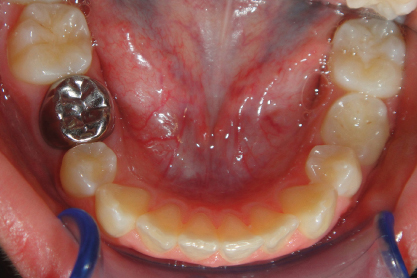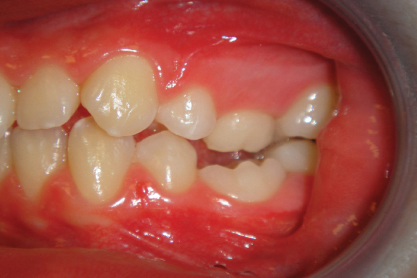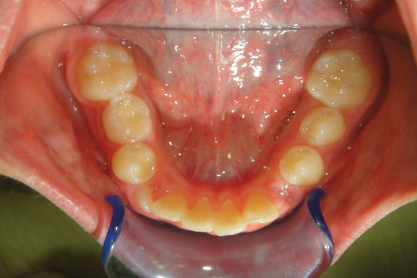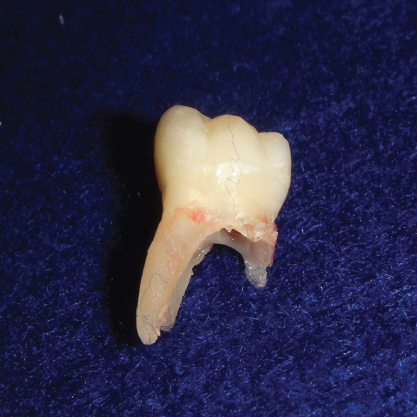Chapter 15
Infraocclusion of mandibular primary molars
Jane A. Soxman
When the occlusal surface of a primary molar is 1 mm or more below the occlusal plane of the adjacent teeth, the primary molar is submerged (Hvaring et al., 2014). Submerging is usually the first clinical indication of an ankylosed primary molar (Figures 15.1 and 15.2). With normal development, adjacent teeth continue to erupt, and vertical bone height of the alveolar bone continues to increase, creating an impression of submerging of the affected primary molar. Ankylosis results from a fusion between the root’s cementum and/or dentin with the surrounding alveolar bone, resulting in cessation of eruption of the primary molar and proximal alveolar bone growth. Interruption in the integrity of the periodontal ligament (PDL) impedes eruptive forces in the ankylosed tooth. A radiograph may or may not show loss of the PDL (American Academy of Pediatric Dentistry, 2014). Since only a small area of the root is affected, detection with a radiograph may be difficult (Tieu et al., 2013). An increase in the occurrence of dental anomalies associated with infraocclusion has been reported. One study reported an increased incidence of distal angulation of the mandibular second premolar, microdontia of maxillary permanent lateral incisors, palatally displaced canines, and tooth agenesis (Shalish et al., 2010). The presence or absence of a permanent successor is a primary factor influencing the treatment plan.

Figure 15.1 Submerging mandibular second primary molar occlusal view.

Figure 15.2 Submerging mandibular second primary molar buccal view.
Submerged with permanent successor
In most cases, exfoliation of the infraoccluded primary molar occurs at the appropriate time without intervention. If a submerged primary molar is maintaining arch length, preventing mesial shift of the first permanent molar, or is not impeding eruption of the permanent successor, the tooth may be maintained until normal exfoliation or until the contralateral primary molar exfoliates (Fricker et al., 2008). If the contralateral primary molar has exfoliated, its permanent successor has erupted, and the infraoccluded primary molar is not mobile, extraction of the infraoccluded primary molar is indicated (Figure 15.3). A periapcial radiograph may be obtained to determine root length of the primary molar and position of the premolar. If the premolar is erupting with a mesial or distal path of eruption, the mesial or distal root of the mandibular primary molar may not resorb, causing infraocclusion and overretention of the mandibular primary molar (Figures 15.4 and 15.5). Crown build-up to preserve space, preventing tipping of adjacent teeth and supereruption of the tooth in the opposite arch may be performed (Dias et al., 2012). With continued retention after loss of the contralateral primary molar, extraction of the retained primary molar is indicated. Distal eruption of the succeeding premolar is a complication that also occurs and warrants consideration of timely extraction and appropriate space management (Tieu et al., 2013). Root development of the permanent successor may be delayed with delayed root resorption of an ankylosed primary molar. If the decision is made not to extract the ankylosed primary molar, both root formation and eruption of the permanent successor, along with root resorption of the ankylosed primary molar, should be periodically evaluated (Nazif et al., 1986).

Figure 15.3 Submerged mandibular right second primary molar with contralateral second premolar erupted.

Figure 15.4 Periapical radiograph showing ectopic eruption of permanent successor.

Figure 15.5 Extracted infraoccluded mandibular second primary molar with lack of distal root resorption.
Stay updated, free dental videos. Join our Telegram channel

VIDEdental - Online dental courses


